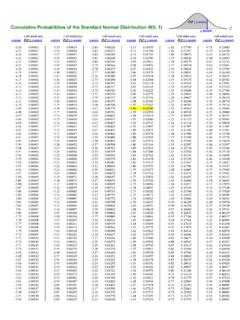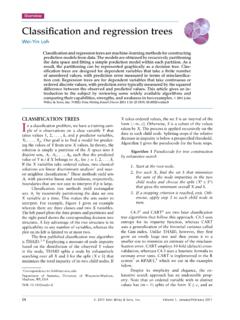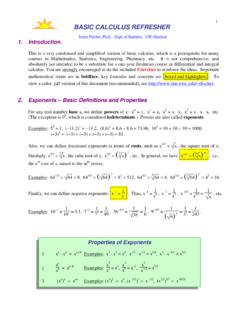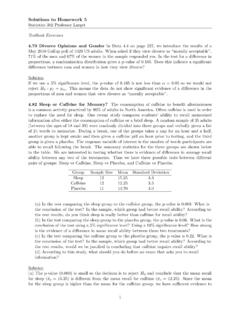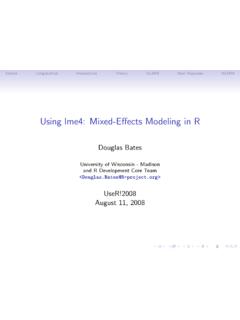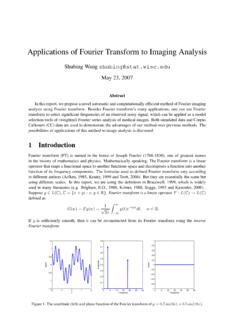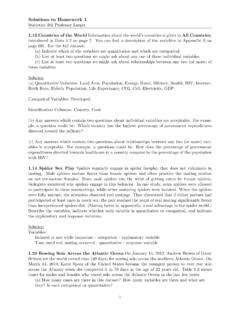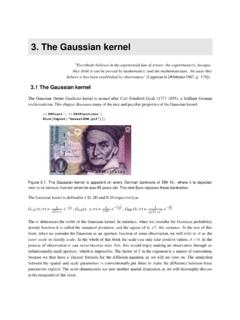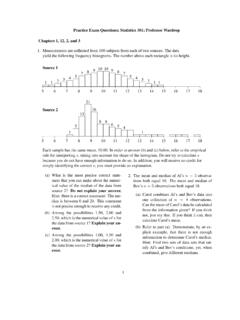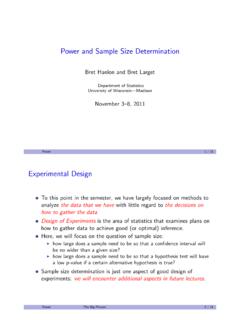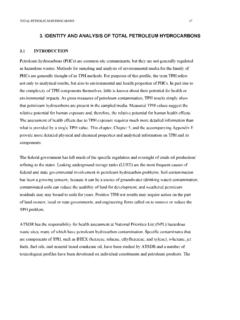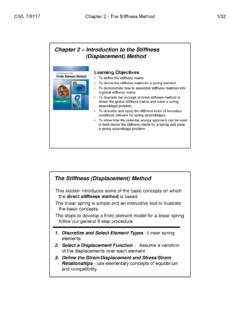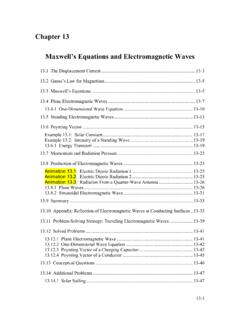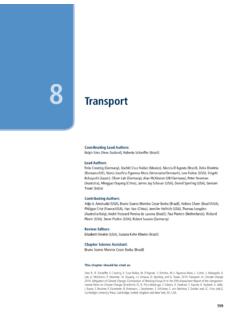Transcription of CHAPTER 8. RANDOMIZED COMPLETE BLOCK DESIGN WITH …
1 CHAPTER 8. RANDOMIZED COMPLETE BLOCK DESIGN WITH AND WITHOUT SUBSAMPLES The RANDOMIZED COMPLETE BLOCK DESIGN (RCBD) is perhaps the most commonly encountered DESIGN that can be analyzed as a two-way AOV. In this DESIGN , a set of experimental units is grouped (blocked) in a way that minimizes the variability among the units within groups (blocks). The objective is to keep the experimental error within each BLOCK as well as possible. Each BLOCK contains a COMPLETE set of treatments, therefore differences among blocks are not due to treatments, and this variability can be estimated as a separate source of variation. The removal of an appreciable amount of this source of variation reduces experimental error and improves the ability of the experiment to detect smaller treatment differences.
2 The greater the variability among blocks the more efficient the DESIGN becomes. In the absence of appreciable BLOCK differences the DESIGN is not as efficient as a completely RANDOMIZED DESIGN (CRD). The CRD has more degrees of freedom for error and a smaller F value is required for significant difference among treatments. The paired sample experiment discussed in CHAPTER 6 is the simplest case of using the concept of blocking, where pairs are blocks. RANDOMIZED COMPLETE BLOCK DESIGN Without Subsamples In animal studies, to achieve the uniformity within blocks, animals may be classified on the basis of age, weight, litter size, or other characteristics that will provide a basis for grouping for more uniformity within blocks. For plants in field trials, land is normally laid out in equal-sized blocks, each BLOCK being subdivided into as many equal-sized plots as there are treatments to be studied.
3 In general, it is most efficient to have a single replicate of each treatment per BLOCK . There may be situations, however, when it is desirable to have more than one replicate per blocks. Randomization After experimental units have been grouped into blocks, treatments are assigned randomly within a BLOCK , and separate randomizations are made for each BLOCK . To illustrate the randomization and the AOV for a RCBD, consider the layout of the field plots in Figure 8-1. The sugar beet root yield data shown in Figure 8-1 are the same as in Table 7-1 and Figure 7-1. This experiment was actually performed as a RCBD but was analyzed as a CRD in CHAPTER 7 to provide a basis for comparing the two designs. The six treatments in each BLOCK were randomly assigned to the six plots by drawing random numbers from Appendix Table A-1 in the manner described in CHAPTER 7.
4 Note in this case that there are only six random numbers (1 - 6) to be drawn for each BLOCK , , for BLOCK 1 the random sequence was 3, 6, 5, 2, 1, and 4. Assigning treatments A-F to numbers 1-6 results in the BLOCK 1 treatment sequence. BLOCK 1 BLOCK 2 BLOCK 3 BLOCK 4 BLOCK 5 C 1 ( ) A 7 ( ) B 13 ( ) D 19 ( ) C 25 ( ) F 2 ( ) D 8 ( ) C 14 ( ) C 20 ( ) D 26 ( ) E 3 ( ) B 9 ( ) D 15 ( ) E 21 ( ) A 27 ( ) B 4 ( ) F 10 ( ) E 16 ( ) A 22 ( ) B 28 ( ) A 5 ( ) E 11 ( ) F 17 ( ) F 23 ( ) E 29 ( ) D 6 ( ) C 12 ( ) A 18 ( ) B 24 ( ) F 30 ( ) Figure 8-1. Field plots layout in a RCBD. Plots are numbered in the lower left. Treatments A-F are levels of nitrogen fertilizer from 0 - 250 lbs/acre in 50 lb increments. The number in parenthesis is the root yield per plot in tons/acre.
5 Analysis of Variance To proceed with the AOV, the results shown in Figure 8-1 are organized by blocks and treatments in Table 8-1. Table 8-1. Sugar beet root yield data (tons/acre). A (0) B (50) C (100) D (150) E (200) F (250)
6 BLOCK ( ) total BLOCK (Yj.) mean 40 A generalized outline of the AOV for a RCBD is shown in Table 8-2. Our main concern in this DESIGN is still to test the equality of treatment means. However, now we can also test for a significant BLOCK effect. Table 8-2. AOV for a RCBD. Source df Sum of squares (SS) Mean square (MS) Observed F total kr-1 TSSS BLOCK r-1 SSB MSB MSB/MSE Treatment k-1 SST MST MST/MSE Exp.
7 Error (k-1)(r-1) SSE MSE The AOV for the data in Table 8-1 is given in Table 8-3. Calculations for completing the table are shown below. Table 8-3. Two-way AOV for the sugar beet yield data. Source df SS MS F total 29 BLOCK 4 Treatment 5 Exp. error 20 Step 1. Outline the AOV table and list the sources of variation and degrees of freedom to provide the entries for the first two columns of Table 8-3. Step. 2. Correct factor (C) C = Y2 ../rk = ( )2 /(5) (6) = where r is the number of blocks. Step 3.
8 total sum of squares (TSS) TSSYYYijCCij= = = = (..)..2244555 61311 13 Step 4. BLOCK sum of squares (SSB) and mean square (MSB). SSBkYYjkcCj= = = = (..)./.2244253 929 44. MSB = SSB/(r-1) = = Step 5. Treatment sum of squares (SST) and mean square (MST). SSTrY YYirCCi= = = = (..)./..2244522 17277 69 MST = SST/(k-1) = = Step 6. Error sum of squares (SEE) and mean square (MSE). SST = TSS - SSB - SST = - - = MSE = SSE/(k-1) (r-1) = 24/(5) (4) = MSE represents the variability among experimental units that is not accounted for by any known source of variation. Thus the sum of squares for error is most easily obtained by subtracting the known sources of variation, , blocks and treatments, from the total variation. To gain some insight into the nature of "experimental error" for this DESIGN , each observation can be expressed in the following form: Yij = + ( i.)
9 - ) + ( .j - ) + ij where is the overall mean (estimated by 4), I. - represents the ith treatment effect (estimated by .), and .j - represents the jth BLOCK effect (estimated by .). Thus the experimental error, ij, is the difference between the observation, Yij and the effects of known sources of variation, ij = Yij - - ( i. - ) - ( .j - ) = Yij - ( i. + j - ) To illustrate, we will calculate the estimated error component for plot 1 (which is treatment C in BLOCK 1), $(..) 313131= + YYYY = - ( + - ) = Performing this calculation for each plot of the experiment will yield the estimated errors. Squaring and summing these errors will result in the sum of squares for experimental error, , SSEYY YYijij= + (.
10 2.) Step 7. Calculate F values For blocks: F = MSB/MSE = = with 4 and 20 df. For treatments: F = MST/MSE = = with 5 and 20 df. The F value for blocks is not significant at the 5% level (Appendix Table A-7), but the F value for treatment is highly significant (P < ) and is considerably larger than the F value obtained when BLOCK effects are ignored in the AOV in CHAPTER 7. DESIGN Efficiency In testing treatment differences, several alternative experimental designs may be used. However, the several designs that may be equally valid for testing treatment effects are rarely equally efficient. Efficiency may be defined in terms of the cost of experimentation, time to collect data, precision of the data obtained, etc.
